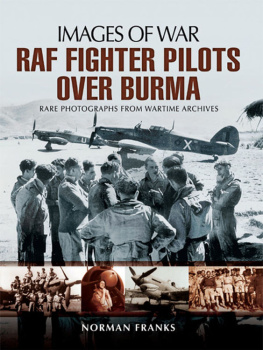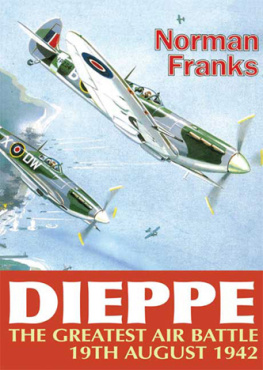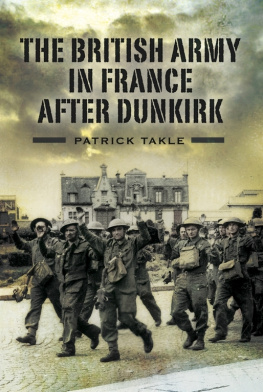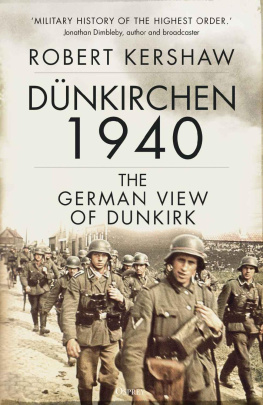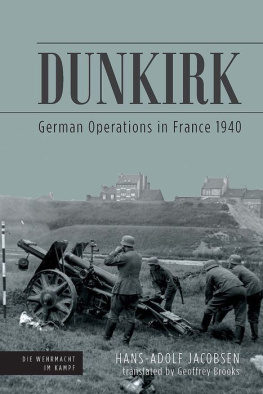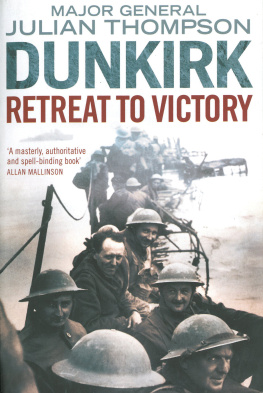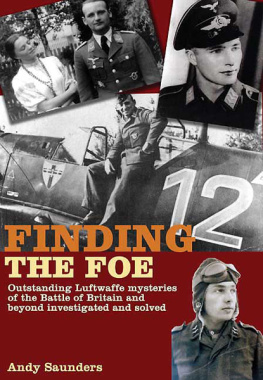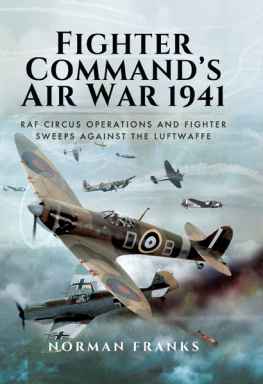Norman Leslie Robert Franks - Air Battle for Dunkirk: 26 May – 3 June 1940
Here you can read online Norman Leslie Robert Franks - Air Battle for Dunkirk: 26 May – 3 June 1940 full text of the book (entire story) in english for free. Download pdf and epub, get meaning, cover and reviews about this ebook. City: London, France--Dunkerque, year: 2000, publisher: Grub Street Publishing, genre: Non-fiction. Description of the work, (preface) as well as reviews are available. Best literature library LitArk.com created for fans of good reading and offers a wide selection of genres:
Romance novel
Science fiction
Adventure
Detective
Science
History
Home and family
Prose
Art
Politics
Computer
Non-fiction
Religion
Business
Children
Humor
Choose a favorite category and find really read worthwhile books. Enjoy immersion in the world of imagination, feel the emotions of the characters or learn something new for yourself, make an fascinating discovery.
- Book:Air Battle for Dunkirk: 26 May – 3 June 1940
- Author:
- Publisher:Grub Street Publishing
- Genre:
- Year:2000
- City:London, France--Dunkerque
- Rating:5 / 5
- Favourites:Add to favourites
- Your mark:
- 100
- 1
- 2
- 3
- 4
- 5
Air Battle for Dunkirk: 26 May – 3 June 1940: summary, description and annotation
We offer to read an annotation, description, summary or preface (depends on what the author of the book "Air Battle for Dunkirk: 26 May – 3 June 1940" wrote himself). If you haven't found the necessary information about the book — write in the comments, we will try to find it.
Norman Leslie Robert Franks: author's other books
Who wrote Air Battle for Dunkirk: 26 May – 3 June 1940? Find out the surname, the name of the author of the book and a list of all author's works by series.
Air Battle for Dunkirk: 26 May – 3 June 1940 — read online for free the complete book (whole text) full work
Below is the text of the book, divided by pages. System saving the place of the last page read, allows you to conveniently read the book "Air Battle for Dunkirk: 26 May – 3 June 1940" online for free, without having to search again every time where you left off. Put a bookmark, and you can go to the page where you finished reading at any time.
Font size:
Interval:
Bookmark:

Published by Grub Street,
The Basement,
10 Chivalry Road,
London SW11 1HT
First published in hardback 1983 under the title Air Battle of Dunkirk
This edition first published 2000
Copyright 2000 Grub Street, London
Text copyright Norman Franks
British Library Cataloguing in Publication Data
Franks, Norman L.R. (Norman Leslie Robert), 1940
Air Battle Dunkirk, 26 May 3 June 1940
1. Great Britain. Royal Air Force History. 2. Dunkerque
(France), Battle of, 1940 3. World War, 1939-1945 Aerial
operations, British
I. Title
940.544941
ISBN 1 902304 50 0
ePUB ISBN: 9781909166493
All rights reserved. No part of this publication may be reproduced, stored in a retrieval system, or transmitted in any form by any means, electronic, mechanical, photocopying, recording, or otherwise, without the prior permission of the copyright owner.
Typeset by Pearl Graphics, Hemel Hempstead
Printed and bound in Great Britain by
Biddles Ltd, Guildford and Kings Lynn
Contents
Appendices:
As with my previous books I was privileged to meet or to correspond with a number of men who flew with the Royal Air Force. In this case, these men listed below all saw action over France and/or over Dunkirk in May and June 1940. They have given generous help and I wish to record my sincere thanks to them all. Sadly, since the original edition of this book, many of them have flown for the last time.
Air Vice-Marshal H.A.C. Bird-Wilson, CBE , DSO , DFC *, AFC *, 17 Squadron
Wing Commander G.C. Unwin, DSO , DFM , 19 Squadron
Air Vice-Marshal J. Worrall, CB , DFC , 32 Squadron
Squadron Leader J.N. MacKenzie, DFC , 41 Squadron
Wing Commander E.A. Shipman, AFC , 41 Squadron
Air Vice-Marshal C.G. Lott, CB , CBE , DSO , DFC , 43 Squadron
Air Commodore A.C. Deere, DSO , OBE , DFC *, 54 Squadron
Air Commodore J.A. Leathart, CB , DSO , 54 Squadron Air Vice-Marshal S.B. Grant, CB , DFC *, 65 Squadron
Wing Commander H.M. Stephen, DSO , DFC *, 74 SquadronGroup Captain A.R. Wright, DFC *, AFC , 92 Squadron
Wing Commander A.C. Bartley, DFC *, 92 Squadron
Air Commodore J.M. Thompson, CBE , DSO , DFC *, AFC ,
111 SquadronWing Commander J.E. Storrar, DFC *, AFC , AE , BS c, MRCVS ,
145 Squadron Wing Commander P.L. Parrott, DFC *, AFC , 145 Squadron Group Captain R.N.H. Courtney, CBE , DFC *, AFC , 151 Squadron
Air Marshal Sir Humphrey Edwardes Jones, KCB , CBE , DFC , AFC , 213 Squadron
Squadron Leader H.A. Haarhoff, DFC , 220 Squadron Group Captain R.A.L. Morant, OBE , 222 Squadron
Squadron Leader G.G.A. Davies, DFC , 222 SquadronAir Marshal Sir Harold Maguire, KCB , DSO , OBE , 229 Squadron
Group Captain Sir Archibald Hope, OBE , DFC , 601 Squadron Group Captain J. Ellis, CBE , DFC *, 610 Squadron
J. E. McComb, CBE , DFC , DL , 611 Squadron 6
Wing Commander Sir Barrie Heath, K t, DFC , 611 Squadron
Wing Commander K.M. Stoddart, AE , 611 Squadron
Group Captain D.E. Gillam, DSO **, DFC *, AFC , 616 Squadron
Air Chief Marshal Sir Harry Broadhurst, GCB , KBE , DSO , DFC ** AFC , Station Commander, Wittering.
I also thank the late Air Commodore A.E. Clouston, CB , DSO , DFC , AFC *, Mrs Sonia McComb, Ministry of Defence and the staff of the Public Records Office. My good friends Chaz Bowyer and Martyn Ford-Jones, and of course to Amy Myers and everyone at Wm Kimber & Co, who originally published this book, and now to John Davies and staff of Grub Street Publishers. Also to Graham Day of the Air Historical Branch, MoD, and my friend and fellow author John Foreman.
Britain and her Empire had been at war for 220 days when Germany finally ended the period known as the Phoney War on 10th May 1940. At dawn on that Friday, German troops suddenly opened their offensive along the Western Front. Across the German frontier came 135 German divisions, streaming into Luxembourg and Belgium while paratroops and gliders descended on objectives in Belgium and Holland. Also in the air came the so far victorious Luftwaffe, attacking Dutch, Belgian and French airfields, and also airfields in France from which British RAF squadrons operated.
Although the advance was not totally unexpected, the attack when it came took the Allied forces by surprise and such opposition that they could muster was soon overwhelmed. In Holland the Dutch Air Force was virtually destroyed by 13th May; Rotterdam was bombed the next day and by the 15th the Dutch Army, though still intact, surrendered.
By this lightning push through Belgium and Holland, the Germans circumvented the famed Maginot Line which separated France from Germany, making this costly defence system impotent.
The British and French had expected an attack to come further to the north and in consequence focussed their attention there. When, therefore, German Panzers pushed through the forested Ardennes region around Sedan, they encountered little opposition. The German spearhead crossed the River Meuse on the night of 11th-12th May, its tanks following. The French troops that were rushed to stem this advance were mostly of low quality and poorly equipped. When scores of Luftwaffe Stuka dive-bombers hit them the way was again open and the split in the Allied forces complete. The Germans made straight for the Channel coast spearheading towards Boulogne and Calais.
Despite spirited fighting in the north, the British and French soldiers were soon pushed back towards Brussels. In the air too the French Air Force and British squadrons of the Advanced Air Striking Force and Air Component were quickly overwhelmed. Although they fought heroically they could not hope to stop the might of the Luftwaffe. The men of the RAF in particular fought themselves to a standstill. Those bombers, Fairey Battles or Bristol Blenheims, not shot down on desperate raids on advancing German columns or bridges, were destroyed on the ground between missions. The Hurricane fighter pilots were quite often totally outnumbered and those who survived moved with the remnants of their squadrons from airfield to airfield as the armies on the ground retreated through the corridor leading to the Channel coast.
These fighter units were re-inforced by other Hurricane and Gladiator squadrons or by flights from British-based squadrons operating in France for short periods or even on a daily basis in France, but against the might of the Luftwaffe whose strength in May 1940 was around 3,500 front line aircraft, including 800 of the latest Messerschmitt 109E single-engined fighters, the odds were just too great.
When the offensive opened the AASF had 135 bombers on strength. Two days later it was down to just over seventy, most of which needed service or repair. Then on 14th May the total remaining bomber force was sent to attack German troops in the Sedan bridgehead. The Messerschmitts and flak were ready for them and forty Battles and Blenheims were shot down.
As the Hurricane squadrons hurled themselves almost hourly against German bombers, dive-bombers and fighters, reinforcements which in number were equivalent to a further twelve full squadrons, also dashed themselves to pieces. They inflicted heavy casualties but sustained severe losses too. By the end of the 15th, the RAF had lost nearly 250 aircraft either destroyed or damaged beyond immediate repair. It could not go on. At home, the Commander-in-Chief of Fighter Command, Air Chief Marshal Sir Hugh Dowding, his establishment in fighter squadrons, fighter aeroplanes and fighter pilots already dangerously below the number set by Air Ministry and the Government, could daily see his fighter force being whittled away with little real effect. To retain a sufficient force to defend the whole of Britain he had to make a stand and deny his fighters being sent to a battle that appeared already lost.
Font size:
Interval:
Bookmark:
Similar books «Air Battle for Dunkirk: 26 May – 3 June 1940»
Look at similar books to Air Battle for Dunkirk: 26 May – 3 June 1940. We have selected literature similar in name and meaning in the hope of providing readers with more options to find new, interesting, not yet read works.
Discussion, reviews of the book Air Battle for Dunkirk: 26 May – 3 June 1940 and just readers' own opinions. Leave your comments, write what you think about the work, its meaning or the main characters. Specify what exactly you liked and what you didn't like, and why you think so.


